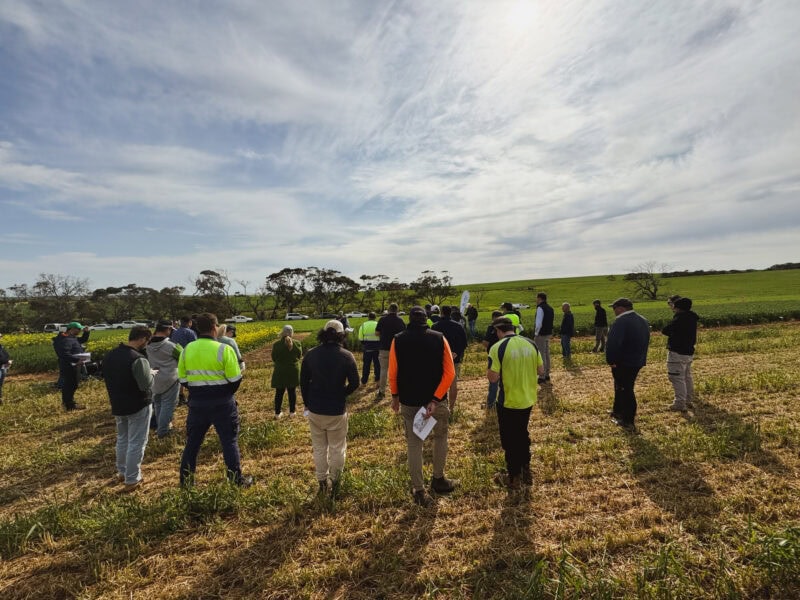2024 AIR EP Lower EP Crop Walk – Finding the farming system “sweet spot”
You could not have forecast a better day. The sun was shining, the canola in full flower, and the view overlooking Marble Range was more spectacular than anything seen on The Block in the last 10 years.
Yes, yes, I know…it’s not the year to be enjoying sunshine. We only want rainbows, following a few inches of soaking rain. But with nothing on the forecast, beggars can’t be choosers.
This year Edillilie turned it on, with over 50 individuals attending the 2024 AIR EP Lower EP Crop Walk. The trial site and surrounding crops looked fantastic, making it even harder to believe the area is currently experiencing a decile 1 rainfall average.
Having received only 200 mm of the average 500 mm for the growing season, many farmers are navigating unchartered waters. In addition to the late, dry start, the cost of doing business seems to be biting harder than ever. Farming was not granted an exemption from the cost-of-living explosion, and yield reductions will challenge our most productive cropping region.
This puts projects such as the GRDC-funded “farming systems enterprise choice and sequence strategies” firmly in the limelight for farmers, who seek to identify the most profitable farming system for their business.
Agronomic Engineer, Rodrigo Coqui da Silva from the University of Adelaide and Research Agronomist, Andrew Ware of EPAG Research provided a trial update, which is now in its second year. Focusing on economics and profitability, over 300 cropping variations will be trialled in comparison to general district practices (the base line).
The trial will use soil analysis to forecast yield, to calculate rates of nitrogen, and to finally determine the maximum yield potential and economics surrounding various cropping scenarios. For many growers in the area, the data from this project cannot come quickly enough.
“The information coming from the farming systems trial is going to be critical for us due to rising input costs”.

Moving alongside the farming systems trial, Andrew Ware gave an update on the GRDC pulse trial, that was ironically planted to wheat this season, to determine the legacy effect of the prior pulse crop. Results from last year indicate lentils came out well in front of lupins economically, however they still carry a higher risk due to waterlogging potential in the area. Beans remain the lowest risk pulse crop option, due to their tolerance to climate and don’t mind ‘wet feet’.
Research to date has shone light on an important aspect of the pulse trial, with Andrew stating, “it has been interesting to see the things that aren’t making a difference – rather than solely focusing on what is making a difference”. Several individuals concurred with this statement, and feel it’s important to identify when there are no significant differences.
In addition to the farming systems and pulse trials, the morning program included a soil pit presentation by Research Agronomist, Brett Masters of EPAG Research. The ironstone over clay soil type, typical in the area, has a history of lime application which provided context to growing lentils in acidic soils. Due to the area having traditional cereal/canola rotations, many were interested in whether maintenance lime rates might change with the introduction of legumes into the rotations. The soil pit, funded by the SA Drought Hub soils and risk project, will be digitally documented and people will be able to access this “virtual soil pit” online. To check out other soils from EP that have been included, check out the Soil Hub website.

As lime rates, application methods and cost become increasingly topical, the program included a visit to Mark Modra’s paddock scale strip demonstration, where he has left a very visual nil strip of lime compared to multiple applications of lime across the rest of the paddock. PIRSA Senior Soil Research Officer, Josh Telfer stepped the audience through hallmark signs of soil acidity effects in lentils, with the paddock site demonstrating the benefits of lime applications over a long period.
As lime takes several years to work its way through the soil profile, many were keen to know whether they could speed up the benefits by incorporating lime into the soil following application. Based on previous trials in NSW, evidence indicates that spreading lime and incorporating by ripping, spading or using a speed tiller (ideally at 2 km/h) will make lime available, more quickly to plants.
Between agronomic sessions, Luke Mosley and Joseph Marks from the University of Adelaide presented soil testing equipment and technology, including penetrometer, laser soil infiltrometer, and infrared device for measuring carbon in soil. The ag tech session concluded with a virtual drone mapping demonstration at the Cummins Bowling Club.